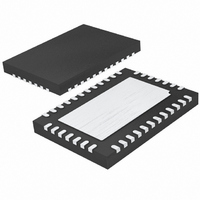LTC2845CUHF#TR Linear Technology, LTC2845CUHF#TR Datasheet - Page 11

LTC2845CUHF#TR
Manufacturer Part Number
LTC2845CUHF#TR
Description
IC TXRX 3.3V MULTIPROTOCOL 38QFN
Manufacturer
Linear Technology
Type
Transceiverr
Datasheet
1.LTC2845IUHFPBF.pdf
(20 pages)
Specifications of LTC2845CUHF#TR
Number Of Drivers/receivers
5/5
Protocol
Multiprotocol
Voltage - Supply
3.3V
Mounting Type
Surface Mount
Package / Case
38-QFN
Lead Free Status / RoHS Status
Contains lead / RoHS non-compliant
Available stocks
Company
Part Number
Manufacturer
Quantity
Price
APPLICATIONS
Mode Selection
The interface protocol is selected using the mode select
pins M0, M1 and M2 (see the Mode Selection table).
For example, if the port is configured as a V.35 interface,
the mode selection pins should be M2 = 1, M1 = 0, M0 = 0.
For the control signals, the drivers and receivers will
operate in V.28 (RS232) electrical mode. For the clock and
data signals, the drivers and receivers will operate in V.35
electrical mode. The DCE/DTE pin will configure the port
for DCE mode when high, and DTE when low.
The interface protocol may be selected simply by plugging
the appropriate interface cable into the connector. The
mode pins are routed to the connector and are left uncon-
nected (1) or wired to ground (0) in the cable as shown in
Figure 10.
The internal pull-up current sources will ensure a binary 1
when a pin is left unconnected and that the LTC2846/
LTC2845 enters the no-cable mode when the cable is
removed. In the no-cable mode the LTC2846/LTC2845
supply current drops to less than 1000 A and all driver
outputs are forced into a high impedance state.
The mode selection may also be accomplished by using
jumpers to connect the mode pins to ground or V
LTC2846
LTC2845
U
DCE/DTE
DCE/DTE
INFORMATION
(DATA)
(DATA)
D4ENB
U
R4EN
M0
M1
M2
M2
M1
M0
Figure 10. Single Port DCE V.35 Mode Selection in the Cable
W
U
IN
.
3.3k
Cable Termination
Traditional implementations have included switching
resistors with expensive relays, or required the user to
change termination modules every time the interface
standard has changed. Custom cables have been used
with the termination in the cable head or separate termina-
tions are built on the board and a custom cable routes the
signals to the appropriate termination. Switching the
termination with FETs is difficult because the FETs must
remain off even though the signal voltage is beyond the
supply voltage for the FET drivers or the power is off.
Using the LTC2846/LTC2845 solves the cable termination
switching problem. Via software control, appropriate ter-
mination for the V.10 (RS423), V.11 (RS422), V.28 (RS232)
and V.35 electrical protocols is chosen.
V.10 (RS423) Interface
A typical V.10 unbalanced interface is shown in Figure 11.
A V.10 single-ended generator output A with ground C is
connected to a differential receiver with inputs A
nected to A, and input C
ground C. Usually, no cable termination is required for
V.10 interfaces, but the receiver inputs must be compliant
with the impedance curve shown in Figure 12.
CONNECTOR
NC
NC
V
IN
2845 F10
'
connected to the signal return
CABLE
LTC2845
sn2845 2845fs
11
'
con-













